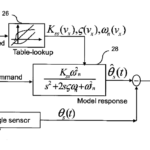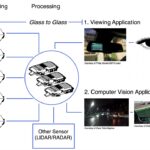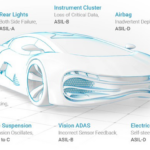Cars with lane-keeping assistance (LKA) also are mandated to have a hands-off detection (HOD) function; there are several ways to meet this challenging requirement.
Where does “hands-off detection” (HOD) come into the picture? (Note: “hands-off detection” is sometimes spelled out as “hands-on detection;” fortunately, the acronym is the same either way.) It is a feature built into the car which signals the driver that their hands have been off the steering wheel for over a vendor-set time period, typically around ten seconds (Figure 1). A maximum time is allowed here, but many automakers choose to use a shorter alarming time window. The indication is both an audible beeping and a message on the console. After a defined hands-off period, the LKA function is then automatically disabled.

Why do you need this HOD alarm? It’s a consequence of the lane-keeping assistance function and how good that can be. It’s human for the driver to try to take advantage of LKA to drive hands-free a much as possible while adjusting the infotainment functions, checking their phone (there are rules and laws about that, too), looking through some papers, unwrapping and eating a meal, and more.
United Nations Economic Commission sets out the need for HOD for Europe (UNECE) regulation No. 79, paragraph 5.1 on steering equipment, which allows fully automated steering only for speeds up to 10 km/hr (6 miles/hr). A new revision released in November 2017 extended the scope of the regulation from automated steering only at vehicle speeds below 10 km/hr to include driver assistance in keeping the vehicle within the chosen lane. (How the United Nations got involved in this regulation-setting is something I am somewhat afraid to investigate.)
For vehicles with an automation level greater than 2, such limitations continue to apply. The rule states that if the driver is not holding the steering wheel after a period of no longer than 15 seconds, an optical warning signal shall be provided (usually via an indication on the console). In addition, if the driver is not holding the steering wheel after a period of no longer than 30 seconds, both an optical and acoustic warning should be provided.
Why focus on hands and the steering wheel with respect to Levels 1 through 5? Having hands on the steering wheel is currently the most reliable indicator of the ability of a human driver to control their vehicle. As a result, hands-off detection is likely to be required by these evolving regulations to operate automated vehicles below the maximum automation level, where control can be transferred to and from the driver.
In theory, all semi-autonomous levels except Level 5 (Full Automation) need to have a way to notify the driver to take control of the wheel quickly and if there’s a problem or special situation. The idea of HOA is to help make that happen, to ensure the driver is at least somewhat ready to take over if called upon to do so.
As with any alarm system, there are two concerns of false positives and false negatives. For false positives, the system mistakenly indicates that their driver has hands-on, when in fact, they do not. Conversely, for a false negative, the system mistakenly indicates that the driver’s hands are off the steering wheel when they actually are on it.
For some applications, false positives or negatives are acceptable as the “price” for the test; that is not the case for automotive applications. A false positive would lead the system to believe the driver is in control while that is not the case. A false negative will annoy the driver, and although not safety-critical by itself, it will affect the driver’s confidence in vehicle control.
How do you determine if the driver’s hand or hands are on the steering wheel? As is often the case in sensing scenarios, it is relatively easy in theory but difficult in practice. There are many exceptions and corner cases that could lead to false positives or negatives. How HOD is implemented is the subject of Part 3 of this article.
Related EE World Content
- The automotive Tire Pressure Monitoring System, Part 1: The situation
- The automotive Tire Pressure Monitoring System, Part 2: Perspectives
- The automotive Tire Pressure Monitoring System, Part 3: Implementation
- The automotive Tire Pressure Monitoring System, Part 4: Issues
- Understanding stop/start automobile-engine design, Part 1: The idea
- Understanding stop/start automobile-engine design, Part 2: The starter motor
- Understanding stop/start automobile-engine design, Part 3: The battery situation
- Understanding stop/start automobile-engine design, Part 4: Mechanical wear issues
- Understanding stop/start automobile-engine design, Part 5: Additional considerations
- Understanding stop/start automobile-engine design, Part 6: Responses and work-arounds
References
- The Wall Street Journal, “ Ding. Chirp. Notifications Are Driving Us Crazy.”
- Jeep Garage, “2019 Cherokee Trailhawk Elite hands off steering wheel alerts”
- Driving, “Lorraine Explains: You can take your hands off the wheel — should you?”
- Subaru Outback, “Hands on the steering wheel warning”
- LinkedIn, “Hands-Off Detection (HOD) – crucial for Driver Assistance and Automated Driving Systems” [capacitive overview]
- EE News Automotive, “Hands-off detection ECU for Autonomous Driving Systems” [Alps Alpine capacitive system]
- National Highway Traffic Safety Administration (NHTSA), “Hands Off Detection Requirements for UN R79 Regulated Lane Keeping Assist Systems” [IEE capacitive solution]
- IEE, “Hands Off Detection (HOD) Sensing System” [IEE capacitive solution]
- IEE/YouTube, “EE – Hands Off Detection (HOD) sensing system” [IEE capacitive solution]
- US Patent US7912665B2/General Motors, “Method and apparatus for driver hands off detection for vehicles with active front steering system“ [torque-based scheme]
- JTEKT ENGINEERING JOURNAL, “Hands On/Off Detection Based on EPS Sensors” [academic paper on torque system]
- AMS-Osram, “Hands-on detection webinar about capacitive sensor technology” [Quadrature scheme]
- AMS-Osram, “New capacitive sensing technology provides a more reliable and safer hands-on detection” [Quadrature scheme]
- AMS-Osram, “Hands-on Detection” (video)
- AMS-Osram, AS8579 Capacitive Sensor data sheet
- Zoppas Industries, “Steering Wheel Hand Detection Systems” [capacitive sensing plus integral heater]
- Microchip Technology/YouTube, “Steering Wheel Demonstration w/ Capacitive Hands off Detection, Touch Pads and Buttons” [capacitive sensing]
- The National Academies of Sciences, Engineering, and Medicine “Hands Off Detection Requirements for UN R79 Regulated Lane Keeping Assist Systems” [“legal” notice on LKA and HOD]
- IEEE, “Hands on the wheel: a Dataset for Driver Hand Detection and Tracking” [use of infrared imaging of back of driver’s hands]
- United Nations Economic Commission for Europe, “World Forum for the harmonization of vehicle regulations” [Role of UN ECE]






Leave a Reply